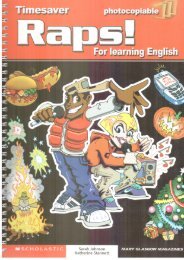English_Book_2-Teacher_300913
English_Book_2-Teacher_300913
English_Book_2-Teacher_300913
You also want an ePaper? Increase the reach of your titles
YUMPU automatically turns print PDFs into web optimized ePapers that Google loves.
INTRODUCTIONTeaching techniquesThe choice of teaching techniques obviouslydepends on the individual classroom situationand your preferred teaching style. Below are somesuggested techniques:➤ Pair and group workMany of the exercises in Postcards are designed sothat students can work in pairs simultaneously.In pair work, students’ talking time is increaseddramatically, and students engage in extensivepractice in a short period of time. It’s importantto vary pairings in class so each student gets anopportunity to work with a variety of others. Varypairs by having students work with the student onthe left, on the right, in front of, or behind them.To assign pairs efficiently, give explicit verbalinstructions and examples, such as Work with thepartner on your right. (pointing to the student at theend of the row) You’re A. (pointing to the student onhis or her right) You’re B. (pointing at the next pair)You’re A; you’re B. (pointing at the next row) You’re A;you’re B. Etc.You can also form random pairs. This worksespecially well when you have pairs stand toperform the exercise. Say, for example: Stand and finda partner you haven’t worked with before. You have fifteenseconds to find a partner. Everybody, stand and find apartner!Students can work in groups when they dodiscussions, task-based activities, role-plays,questionnaires, and projects. Group work is aneffective vehicle for encouraging cooperation andindependent learning. It also provides shy studentsthe opportunity to open up and participate. Youcan form groups with students of similar ability sothat each student is performing at his or her level.Alternatively, you can form groups of students withmixed ability so that the more capable students canhelp others. As with pairs, vary group members sostudents are exposed to a variety of others. To assigngroups efficiently, give explicit instructions andexamples of how students are to form their groups.Setting up: modeling and time limitsWhen students will be working independently inpairs or groups, follow written or verbal instructionswith a model to ensure all students understand howto proceed. Depending on student level and thecomplexity of the task, you may wish to model inmore than one of the following ways to make surestudents know what to do:• <strong>Teacher</strong> to self (T-T):T: What’s your name? (Pause) I’m Mr. Mori.• <strong>Teacher</strong> to student (T-S):T: (Pointing to student) What’s your name? S: I’m Taro.• Student to teacher (S-T):T: (Pointing to student) Ask me. S: What’s yourname? T: I’m Mr. Mori.• Student to student (S-S):T: (Pointing to student) Ask Taro. S1: What’s yourname? S2: I’m Taro.• Student 1 to Student 2 to Student 3, etc., in a chain(S1-S2-S3):T: (Pointing to student) Taro, ask Miki. Miki, answerand ask Tomo. Tomo, answer and ask the next student,and so on. S1: What’s your name? S2: I’m Miki.What’s your name? S3: I’m Tomo. What’s your name?S4: I’m . . .To make sure students are focused and work quickly,set a time limit for the task. Warn students halfwaythrough the task how many minutes they have left.Warn them again one minute or so before the timeis up.Monitoring and correctionAfter modeling, it’s important to move aroundthe classroom and unobtrusively monitor pairs orgroups. While monitoring:• Make sure students are demonstrating thatthey understand how to do the exercise; if moststudents have not understood, you may need todo another model.• Make sure that students are using the main targetlanguage (the grammatical or lexical focus ofthe practice) correctly; if most students are not,you may want to stop to do a quick review andencourage students to pay attention to languageusage.• Don’t correct minor errors. Just take note of anyimportant ones or ones which would be helpfulfor the whole class to give feedback on later.• Move unobtrusively from group to group to help,encourage, and praise students as needed. Listenfor pairs or groups with typical or interestingconversations—you may wish to call on these toshare their work during the check.Following through: checkingAfter pairs or groups have finished an exercise, itis important to check by calling on a few pairs orgroups to present their exchanges, ideas, summaries,etc., to the class. This will allow the class to seetypical or interesting examples of pair and groupwork, and provide feedback and closure. Fordialogues and exchanges, call on pairs or groupsto stand and perform for the class. For discussions,you may wish to call on one person from the pair orgroup to summarize the conversation.➤ Repetition and choral practiceRepetition and choral practice helps studentsreproduce and remember sounds, words, andstructural patterns. Repeating chorally can also helpstudents gain confidence before they are asked toperform individually. Repetition and choral practicecan be used with Dialogues, Putting it togetherphotostories, Grammar focus charts, Pronunciationexercises, Vocabulary lists, Useful expressions, andCommunication and Speaking exchanges.viiiPostcards_splitB_TE1_FM.indd viii2/27/07 10:23:14 AMPostcards




